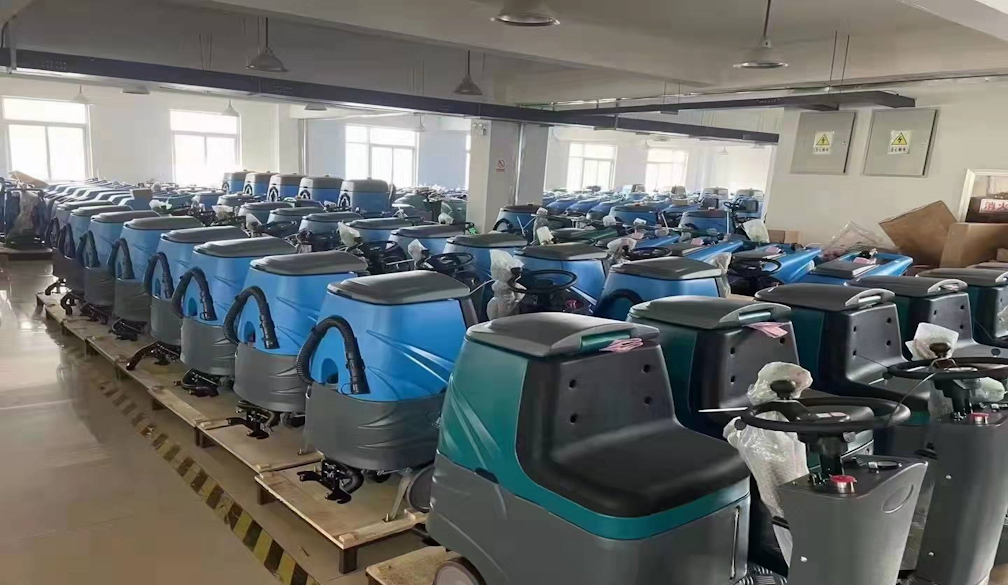Smart Technology Integration in Ride-On Sweepers

Ride-on sweepers assume a pivotal part in keeping up with tidiness in different conditions, from city roads and parking garages to modern offices and stockrooms. In any case, the customary sweepers of the past are continuously giving approaches to further developed, productive, and practical machines. This change is driven by the coordination of brilliant innovation into ride-on sweepers. In this article, we will investigate the advantages and uses of shrewd innovation in ride-on sweepers, featuring how it upgrades productivity, manageability, and by and large execution.
The Evolution of Ride-On Sweepers
Before delving into the integration of smart technology, it's essential to understand the evolution of ride-on sweepers. These machines have come a long way since their inception. Early sweepers were often manually operated or pulled by horses, and their cleaning capabilities were limited. Over time, advances in engineering and technology have transformed sweepers into sophisticated machines capable of cleaning large areas efficiently.
The Need for Efficiency and Sustainability
Efficiency and sustainability are two critical factors in modern industrial and urban cleaning operations. Traditional sweepers, while effective to some extent, often fell short in these areas. They consumed large amounts of fuel, emitted pollutants, and required significant manpower to operate. In response to these challenges, manufacturers began integrating smart technologies into ride-on sweepers.
Key Smart Technologies in Ride-On Sweepers
IoT Sensors
Internet of Things (IoT) sensors are at the heart of smart technology integration in ride-on sweepers. These sensors collect and transmit data in real-time, allowing operators to monitor various aspects of the sweeper's performance. Common data points include fuel consumption, engine temperature, brush wear, and dust levels. This information enables operators to make informed decisions and optimize the sweeper's efficiency.
GPS and Route Optimization
GPS technology enables ride-on sweepers to navigate routes with precision. By utilizing GPS data, sweepers can follow pre-programmed routes, ensuring that no area is missed during the cleaning process. Additionally, route optimization algorithms can minimize travel time and fuel consumption, further enhancing efficiency.
Automated Cleaning Modes
Smart sweepers can operate in different modes, including manual, semi-automatic, and fully automatic. In manual mode, operators have full control over the sweeper's movements, while semi-automatic mode allows for some automation in brush operation and dust collection. Fully automatic mode allows the sweeper to operate autonomously, following a predetermined route and adjusting its cleaning parameters as needed.
Environmental Sensors
To promote sustainability, many modern sweepers are equipped with environmental sensors that monitor air quality and emissions. These sensors help ensure that the sweeper's operation does not negatively impact the environment or pose health risks to operators and bystanders. If pollution levels exceed predefined thresholds, the sweeper can automatically adjust its settings to reduce emissions.
4. Benefits of Smart Technology Integration
Enhanced Efficiency
One of the primary advantages of integrating smart technology into ride-on sweepers is the significant improvement in efficiency. IoT sensors and GPS technology enable real-time monitoring and route optimization, reducing fuel consumption and operational costs. Moreover, automated cleaning modes reduce the need for constant operator intervention, allowing for longer cleaning sessions without operator fatigue.
Cost Savings
Smart sweepers can result in substantial cost savings over their operational lifespan. Reduced fuel consumption, minimized maintenance requirements, and optimized cleaning routes all contribute to lower operating costs. Additionally, fewer manual labor hours are needed, leading to reduced labor expenses.
Improved Cleaning Performance
Smart technology enhances cleaning performance by ensuring that no areas are missed during the sweeping process. GPS-guided sweepers follow precise routes, while environmental sensors help maintain optimal cleaning conditions. This results in cleaner and safer environments, whether it's a city street, parking lot, or industrial facility.
Sustainability and Environmental Benefits
The integration of environmental sensors and emission controls promotes sustainability. Smart sweepers can minimize their environmental footprint by adjusting operations in response to air quality data. This not only benefits the environment but also helps organizations meet regulatory compliance and reduce their carbon footprint.
Operator Comfort and Safety
Smart technology enhances operator comfort and safety. Automated cleaning modes reduce the physical strain on operators, while environmental sensors ensure that operators are not exposed to hazardous dust or pollutants. Additionally, GPS-guided navigation reduces the risk of accidents and collisions.
Applications of Smart Ride-On Sweepers
Urban Cleaning
Smart ride-on sweepers are increasingly used in urban areas to maintain cleanliness in streets, sidewalks, and public spaces. Their ability to follow predefined routes and adjust cleaning parameters based on real-time data makes them valuable tools for municipal cleaning departments.
Industrial Facilities
Industrial facilities, including warehouses, manufacturing plants, and distribution centers, benefit from the efficiency and precision of smart sweepers. These machines can clean vast areas quickly and effectively, ensuring a safe and dust-free environment for workers.
Parking Lots and Airports
Parking lots and airports require regular sweeping to remove debris and maintain a clean appearance. Smart sweepers equipped with GPS can navigate complex layouts and efficiently clean large parking areas and runways.
Construction Sites
Construction sites often generate large amounts of dust and debris. Smart ride-on sweepers equipped with environmental sensors can help mitigate these issues by continuously monitoring air quality and adjusting cleaning operations accordingly.
Challenges and Considerations
While smart technology integration offers numerous benefits, it also comes with challenges and considerations. Some of these include:
Initial Cost
The upfront cost of smart ride-on sweepers may be higher than that of traditional models. However, the long-term cost savings and operational efficiencies typically outweigh the initial investment.
Training
Operators may require training to effectively use the advanced features of smart sweepers. Training programs should cover not only operation but also maintenance and troubleshooting.
Data Security
Collecting and transmitting data from sweepers to centralized systems raises concerns about data security. Manufacturers and organizations must implement robust cybersecurity measures to protect sensitive information.
Maintenance and Upgrades
Regular maintenance is essential to keep smart sweepers operating at peak performance. Additionally, as technology evolves, it may be necessary to upgrade or replace older models to take advantage of the latest features and capabilities.
Future Trends and Developments
The integration of smart technology into ride-on sweepers is an evolving field. Some future trends and developments to watch for include:
AI and Machine Learning
AI and machine learning algorithms can further optimize cleaning routes and operations. These technologies can analyze historical data to make predictive maintenance recommendations and adapt to changing cleaning environments.
Autonomous Sweepers
Fully autonomous ride-on sweepers may become more prevalent in the future. These machines can operate without human intervention, making cleaning operations even more efficient and cost-effective.
Sustainability Focus
The trend towards sustainability is likely to continue, with sweeper manufacturers developing cleaner and more environmentally friendly solutions. This may include the use of alternative fuels or fully electric sweepers.
Conclusion
The integration of smart technology into ride-on sweepers represents a significant leap forward in efficiency, sustainability, and overall performance. These machines are transforming the way we maintain cleanliness in urban, industrial, and commercial settings. By leveraging IoT sensors, GPS navigation, and automated cleaning modes, organizations can achieve cost savings, improved cleaning results, and reduced environmental impact. As technology continues to evolve, the future holds even more promising advancements in the world of smart ride-on sweepers, making them indispensable tools for modern cleaning operations.

